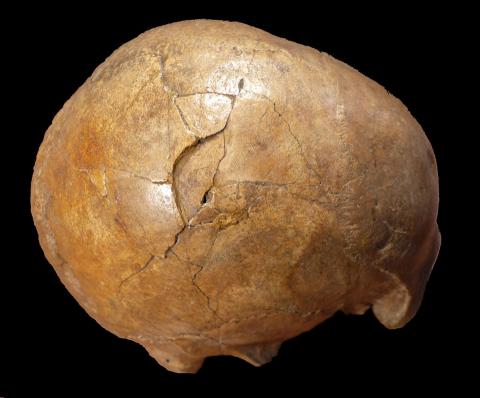Computer simulations using twelve synthetic bone spheres tested scenarios such as falls from various heights as well as single or double blows from rocks or bats. Along with these simulations, the authors inspected the fossil both visually and virtually using computed tomography technology.
The authors of a new paper found there were actually two injuries at or near the time of death: a linear fracture at the base of the skull, followed by a depressed fracture on the right side of the cranial vault. The simulations showed that these fractures strongly resemble the pattern of injury resulting from consecutive blows with a bat-like object; the positioning suggests the blow resulting in the depressed fracture came from a face-to-face confrontation, possibly with the bat in the perpetrator's left hand. The researchers' analysis indicates that the two injuries were not the result of accidental injury, post-mortem damage, or a fall alone.

Right lateral view of the Cioclovina calvaria exhibiting a large depressed fracture. Credit: Kranoti et al, 2019
This is not uncommon. Though the paleolithic is a popular name for a completely fake diet in the 21st century, it was a rough existence. Though the Upper Paleolithic was a time of increasing cultural complexity and technological sophistication, violent interpersonal behavior and murder - along with nature wanting to kill everything - remained part of the behavioral repertoire of early modern Europeans.
While the fractures would have been fatal, only the fossilized skull has been found so it's possible that bodily injuries leading to death might also have been sustained. Regardless, the authors state that the forensic evidence described in this study points to an intentionally-caused violent death, adding to the weight of evidence that homicide was occurring early humans during the Upper Paleolithic.






Comments